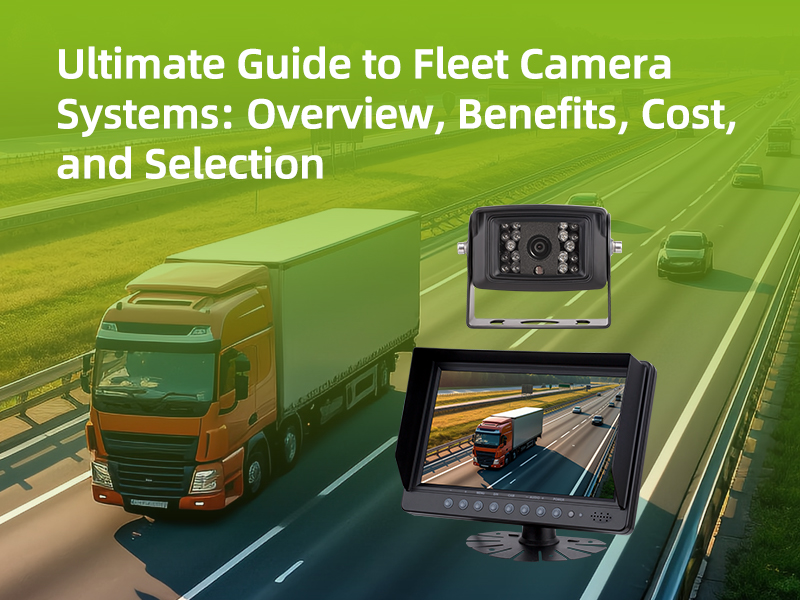Ultimate Guide to Fleet Camera Systems: Overview, Benefits, Cost, and Selection
Fleet camera systems are increasingly becoming an essential tool for fleet management. This comprehensive guide offers insights into what they are, their benefits, legality, and more. Additionally, we’ll explore the cost considerations, how to select the right system, and installation pointers. Let’s delve in.

What is a Fleet Camera System?
A fleet camera system is a comprehensive set-up of cameras, usually both on the exterior and interior of vehicles, which helps fleet managers monitor and manage their vehicles efficiently. These systems are integrated with technology to record real-time data, providing valuable insights for fleet operations.
How Do Fleet Camera Systems Work?
These systems utilize a combination of hardware (cameras) and software (data management platforms). The cameras continuously capture footage while the vehicle is operational. This data is either stored locally or transmitted to a centralized system where fleet managers can review it. Advanced systems may also offer features like real-time monitoring, geo-fencing, and alerts for specific events like harsh braking.
Benefits of Using Fleet Camera Systems
- Safety Improvements: By monitoring driver behavior, managers can offer feedback to ensure safer driving habits.
- Evidence in Disputes: In the event of accidents, camera footage can serve as evidence, clarifying the situation.
- Operational Efficiency: Fleet managers can optimize routes and address maintenance issues promptly.
- Improved Customer Service: Managers can provide accurate delivery updates to customers based on real-time data.
Are Fleet Camera Systems Legal?
The legality of fleet camera systems varies by region. Generally, in many countries, they’re legal provided that drivers and passengers are informed of the monitoring. It’s crucial to ensure that any camera installations adhere to local privacy laws and regulations.
Do Fleet Camera Systems Reduce Insurance Costs?
Yes, many insurance providers offer reduced premiums for fleets equipped with camera systems. These systems can help prove fault in accidents, leading to quicker claim resolutions. Moreover, they emphasize the fleet’s commitment to safety, making them a lower risk in the eyes of insurers.
Top Fleet Camera System Brands
- Luview: A professional fleet camera and fleet camera system manufacturer from China. Visit Luview for more details.
- Rearview Safety: Known for its robust range of safety solutions, Rearview Safety has made a mark in the industry. Check them out.
- Fleetcam: Specializing in advanced fleet monitoring, Fleetcam offers cutting-edge technology. Explore Fleetcam.
Cost of a Fleet Camera System
The cost varies based on features, brand, and installation needs. Basic systems can start at a few hundred dollars per vehicle, while advanced setups with real-time monitoring can cost significantly more. It’s essential to consider both initial investment and potential long-term savings (like reduced insurance premiums) when evaluating cost.
How to Choose the Right Fleet Camera
When selecting a system:
- Evaluate Your Needs: Consider the size of your fleet, routes, and specific challenges.
- Research Brands: Brands like Luview offer a range of products tailored to different fleet needs.
- Check Features: Ensure the system provides real-time monitoring, storage options, and good camera resolution.
- Seek Recommendations: Consult other fleet managers or industry peers for their insights.
For those seeking a reliable fleet camera system supplier, Luview stands out. Don’t hesitate to contact us for more details.
How to Install a Fleet Camera System
Installation varies based on the system. However, here are general steps:
- Choose the Camera Placement: Common areas include the dashboard, rear, and sides of the vehicle.
- Mount the Cameras: Use the provided mounts and ensure they’re securely attached.
- Connect to Power Source: Typically, cameras connect to the vehicle’s electrical system.
- Set Up Data Storage/Transmission: Depending on the system, set up local storage or cloud-based transmission.
- Test the System: Before deploying the vehicle, ensure cameras are functioning and data is accessible.
In conclusion, fleet camera systems have revolutionized fleet management, offering enhanced safety, operational efficiency, and potential cost savings. By selecting the right system and ensuring proper installation, fleet managers can make a significant positive impact on their operations.



